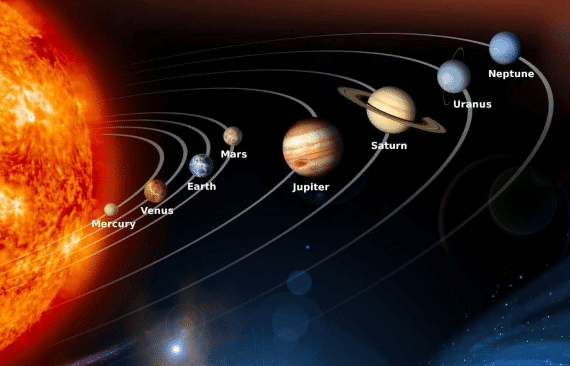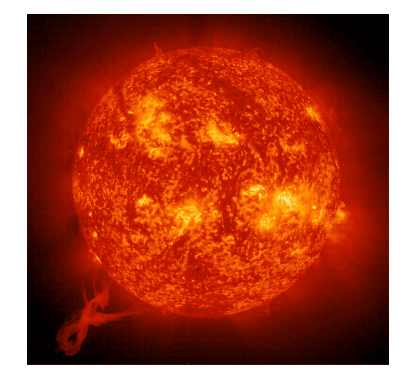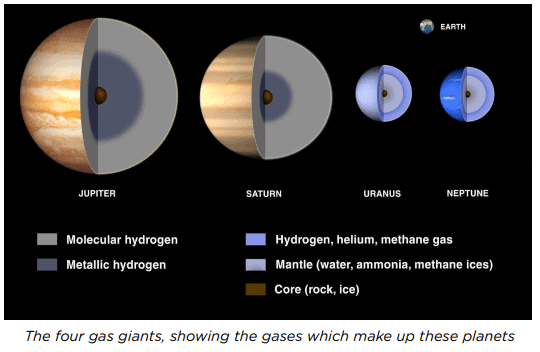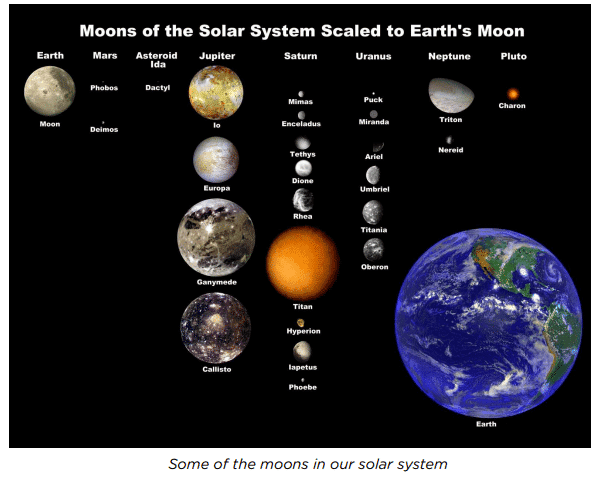The Solar System Chapter Notes | Natural Science and Technology (Grade 6-B) PDF Download
| Table of contents |

|
| The Solar System |

|
| The Sun |

|
| Planets |

|
| Asteroids |

|
| Moons |

|
| Stars vs. Planets |

|
| Points to Remember |

|
| Difficult Words |

|
| Summary |

|
The Solar System
The solar system is our cosmic neighborhood, consisting of the Sun, eight planets, their moons, asteroids, and other objects, all held together by the force of gravity. This section explores the components of the solar system and how they interact.

Components of the Solar System
The Sun: The Sun is a star at the center of the solar system. It is a massive ball of hot gases, producing its own light and heat through nuclear reactions.- It is much larger than Earth (420 times bigger) and the Moon (1700 times bigger).
- The Sun’s core is extremely hot, reaching about 15,000,000°C, while its surface is around 5,500°C.
- The Sun’s gravity keeps all planets in their orbits.
Planets: There are eight planets that orbit the Sun. They do not produce their own light but reflect sunlight.
- The planets are divided into two groups: inner rocky planets and outer gas giants.
Asteroids: These are rocky objects, smaller than planets, that orbit the Sun, mostly found in the asteroid belt.
Moons: Natural satellites that orbit planets. Most planets have moons, with Earth having one and Jupiter having over 60.
How Planets Move
- Planets move in elliptical paths called orbits around the Sun due to the Sun’s gravitational pull.
- The Earth takes 365.25 days (one year) to complete one orbit, traveling at about 100,000 km/h.
- Gravity acts like an invisible string, keeping planets in their orbits without letting them drift away.
The Sun
The Sun is the heart of the solar system, providing light and heat that sustain life on Earth. It is a star, unlike planets, because it generates its own energy.

Characteristics of the Sun
- Composition: The Sun is a ball of hot gases, primarily hydrogen and helium.
- Temperature: The core is about 15,000,000°C, and the surface is around 5,500°C.
- Energy Production: The Sun’s energy comes from nuclear fusion, where hydrogen atoms combine to form helium, releasing tremendous energy.
- Appearance: The Sun appears larger and brighter than other stars because it is much closer to Earth.
- Surface Features: The Sun has dark spots called sunspots and occasional bursts of gas, like solar flares, visible in images.
Importance of the Sun
- The Sun’s heat warms Earth’s surface, making it habitable.
- Its gravity holds the solar system together, guiding the orbits of planets and other objects.
Planets
Planets are large bodies that orbit the Sun and reflect its light. They are divided into two groups based on their composition and distance from the Sun: inner rocky planets and outer gas giants.
Inner Rocky Planets
The four planets closest to the Sun are called the inner planets. They are made of rock and have solid surfaces.
Mercury:
- Closest to the Sun and the smallest planet.
- No atmosphere, with a grey surface covered in thousands of craters from space rock impacts.
Venus:
- Second closest to the Sun, almost the same size as Earth.
- Covered in thick clouds of carbon dioxide and sulfuric acid, making it the hottest planet due to a greenhouse effect.
- Shines brightly in the evening or morning sky, often called the “evening star” or “morning star” (though it’s not a star).
Earth:
- Third planet from the Sun, known as the blue planet due to its water.
- Has a thin atmosphere, liquid water, and soil, supporting life.
- Orbits the Sun in 365.25 days, causing the four seasons: summer, autumn, winter, and spring.
Mars:
- Fourth planet, known as the red planet due to iron oxide (rust) in its soil.
- Has a thin carbon dioxide atmosphere, not breathable for humans.
- Features deep valleys and evidence of past water, suggesting possible ancient life.
- Takes nearly two Earth years to orbit the Sun; a day (sol) on Mars is similar to an Earth day.
Outer Gas Giants
The four planets farthest from the Sun are called gas giants. They are massive, made mostly of gases, and have no solid surfaces.

Jupiter:
- The largest planet, bigger than all others combined.
- A ball of hydrogen and ammonia gases with a light pink-brown color.
- Has strong winds, a possibly hot rocky core, four large moons, and over 60 smaller ones.
Saturn:
- Almost as large as Jupiter, with a light yellow color.
- Known for its rings made of rock and ice particles.
- Has about 62 moons, including Titan, its largest.
Uranus:
- A smooth blue-green gas ball with faint markings.
- Has more than 25 moons and a very cold atmosphere.
Neptune:
- Furthest from the Sun, similar to Uranus in appearance.
- Has a stormy surface with huge storms and winds, about 12 moons, and a cold gaseous composition.
Planet Characteristics
- Orbits: Each planet follows a unique orbit, with Mercury’s being the shortest and Neptune’s the longest.
- Atmospheres: Inner planets have thin or no atmospheres; gas giants have thick gaseous layers.
- Moons: Most planets have moons, except Mercury and Venus.
- Surface Features: Rocky planets have craters and valleys; gas giants have swirling clouds and storms.
Asteroids
Asteroids are rocky objects that orbit the Sun, much smaller than planets. They are remnants of broken planets from long ago.
The Asteroid Belt
- Location: The asteroid belt is a ring of asteroids located between the orbits of Mars and Jupiter.
- Composition: Asteroids are pieces of rock, ranging from the size of small stones to larger than a school building.
- Speed: They travel very fast, up to 25 km/s, faster than a bullet.
- Spacing: Asteroids are spread far apart in space, making collisions with spacecraft rare.
Significance of Asteroids
- Historical Clues: Asteroids are leftovers from the solar system’s formation, providing insights into its history.
- Space Exploration: Spacecraft like Pioneer 10 safely crossed the asteroid belt to reach Jupiter, showing that asteroids are not densely packed.
Moons
Moons are natural satellites that orbit planets. They vary in size, number, and features across the solar system.
Earth’s Moon
Characteristics:- Earth’s only moon, much smaller than Earth.
- Has a pale grey surface with dark grey marks, covered in craters from space rock impacts.
- No atmosphere, water, or wind, so craters and astronaut footprints remain unchanged.
Light: The Moon does not produce its own light; it reflects sunlight, appearing bright at night.
Appearance:
- Can be seen during the day, depending on its phase.
- Appears to change shape (e.g., crescent, full) due to its orbit around Earth.
- Looks larger when rising due to an optical illusion, but its size remains constant.
Surface Features:
- Craters from space rock impacts.
- Light-colored mountains and darker plains, some formed by ancient volcanic lava.
Moons of Other Planets
- Mars: Has two small moons, Phobos and Deimos, both with cratered surfaces.
- Jupiter: Has over 66 moons, with four large ones (discovered by Galileo) being the most prominent.
- Saturn: Has about 62 moons, with Titan being the largest.
- Uranus: Has more than 25 moons.
- Neptune: Has about 12 moons, possibly more.
- Mercury and Venus: These planets have no moons.
- Pluto: A dwarf planet with three known moons.

Importance of Moons
- Moons provide information about their parent planets’ history and composition.
- They vary greatly in size and appearance, from Earth’s large Moon to Mars’ tiny, irregular moons.
Stars vs. Planets
Stars and planets are distinct celestial bodies, often confused due to their appearance in the night sky. This section clarifies their differences.
Stars
- Nature: Stars are massive, hot balls of gas that produce their own light and heat through nuclear fusion.
- Distance: Stars are very far from Earth, appearing as tiny points of light.
- Movement: Stars appear fixed in patterns (constellations) and do not orbit the Sun.
- Visibility: Millions of stars are visible with telescopes, forming constellations like the Southern Cross.
Planets
- Nature: Planets are cooler, solid, or gaseous bodies that reflect sunlight, not producing their own light.
- Distance: Planets are much closer to Earth than stars, appearing brighter and larger in the sky.
- Movement: Planets orbit the Sun and change positions nightly relative to stars, earning the name “wanderers” (from the Greek word “planetes”).
- Visibility: Only eight planets are visible in our solar system, some (like Venus and Mars) with the naked eye.
Historical Observations
- Ancient astronomers, like Hypatia of Alexandria, studied the movement of planets and stars, noting that planets shifted positions while stars remained fixed.
- Over centuries, observatories recorded planetary movements, leading to the understanding that Earth and other planets orbit the Sun.
Points to Remember
- The word “solar” comes from the Latin word “sol,” meaning “sun.”
- Earth orbits the Sun in 365.25 days, causing the four seasons: summer, autumn, winter, and spring.
- Before reaching Jupiter, spacecraft must pass through the asteroid belt, a region of rocky debris between Mars and Jupiter.
- Galileo was the first person to observe Jupiter’s moons, a significant discovery in astronomy.
- The footprints of astronauts on the Moon remain intact because there is no wind or water to erode them.
Difficult Words
- Astronomy: The science of studying stars, planets, and other objects in space.
- Orbit: The curved path an object (like a planet or moon) follows around another object due to gravity.
- Gravity: The force that pulls objects toward each other, keeping planets in orbit around the Sun.
- Constellation: A pattern of stars in the sky that appears fixed, like the Southern Cross.
- Crater: A round hole on a planet or moon’s surface caused by the impact of a space rock.
- Asteroid: A rocky object, smaller than a planet, that orbits the Sun, often found in the asteroid belt.
- Gas Giant: A large planet made mostly of gases, like Jupiter, with no solid surface.
- Nuclear Fusion: The process in the Sun’s core where hydrogen atoms combine to form helium, releasing energy.
- Sunspot: A dark, cooler area on the Sun’s surface.
- Solar Flare: A sudden burst of gas and energy from the Sun’s surface.
Summary
The solar system is a fascinating collection of the Sun, eight planets, moons, asteroids, and other objects, all bound by gravity. The Sun, a star, provides light and heat, while planets orbit it in distinct paths. The inner planets (Mercury, Venus, Earth, Mars) are rocky, while the outer planets (Jupiter, Saturn, Uranus, Neptune) are gas giants. Asteroids, found mainly in the asteroid belt between Mars and Jupiter, are rocky remnants of ancient planets. Moons orbit most planets, with Earth’s Moon reflecting sunlight and featuring craters and plains. Unlike stars, which produce their own light and remain fixed in constellations, planets reflect sunlight and move across the sky. Ancient astronomers’ observations helped us understand that Earth and other planets orbit the Sun, shaping our modern view of the solar system.
FAQs on The Solar System Chapter Notes - Natural Science and Technology (Grade 6-B)
| 1. What is the role of the Sun in the Solar System? |  |
| 2. How are planets different from stars? |  |
| 3. What are asteroids and where are they found in the Solar System? |  |
| 4. How many moons are there in the Solar System? |  |
| 5. What are some key points to remember about the Solar System? |  |















